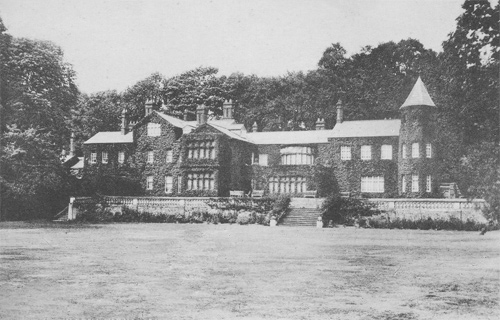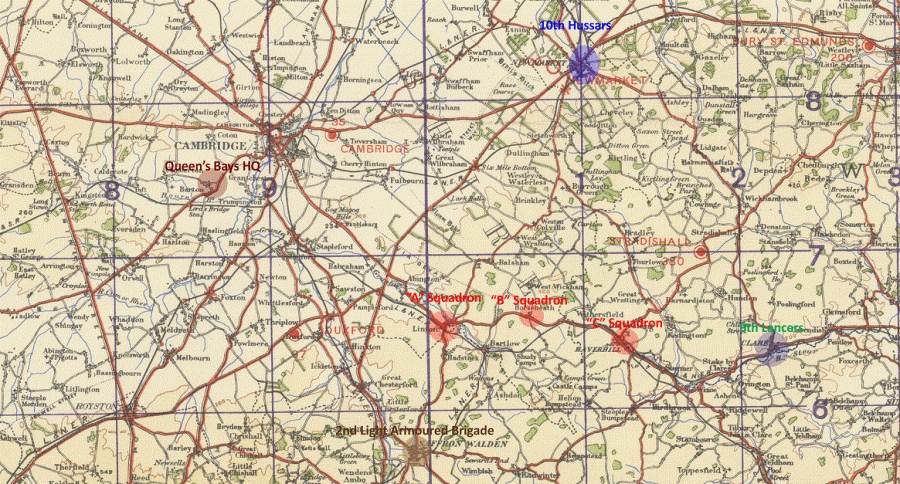The move to the east coast commenced on Friday, 3rd November. The fighting Regimental H.Q. and “A” Squadron were billeted overnight after arriving in Cambridge at 1730hrs. The tanks and baggage remained on the train in a siding. “B” and “C” Squadrons arrived the following morning.
The move was carried out as a part of the ‘Julius Caesar’ plan[i] and involved the entire 1st Armoured Division moving to the area of Newmarket-Saffron Walden-Bishops Stortford-Luton-Shefford, within Eastern Command. The 1st Armoured Division was ‘responsible for internal security and counter-invasion’ in the area, to guard the east coast from the Yorkshire Wolds down to Harwich, and from the coast to Luton and Bedford.[ii]
The 10th Hussars billeted in Newmarket, which they reported as being ‘a good station, where life in billets and requisition buildings occurred for the first time.’ [iii] The 9th Lancers, excluding “C” Squadron ‘which was accommodated nearby,’ was billeted in the village of Clare.[iv] At this time, the 1st Regiment, Royal Artillery was stripped from the Division and sent to France, as Gort wanted as much artillery as possible in support of the BEF.[v]
The Queen’s Bays were, upon arrival in their billeting area, billeted such that:
H.Q. Squadron Bartlow House, Bartlow[vi]

“A” Squadron Linton
“B” Squadron Horseheath
“C” Squadron Haverhill
Billeting for “B” Squadron changed quite quickly, moving to Haverhill with “C” Squadron, as Horseheath was found to be unsuitable[vii].

While settling into the billets, the Bays established a roster of fighting squadrons, commencing with “A” Squadron, and a troop of “C” Squadron, holding themselves at one-hour notice to move, with the remainder of the Regiment at six-hour notice.
Local danger points, the routes to them and the surrounding areas, were reconnoitred by the Squadron Leaders. Further reconnaissance details were carried out through November, leading to a report sent to 2nd Light Armoured Brigade.
For the 1st Armoured Division, throughout the rest of November, training continued, although it became steadily more difficult due to the widespread dispersion of the troops[viii] and the paucity in equipment. The Division continued to be deficient in equipment and armoured vehicles, as the table[ix] below shows:
| War Diary, 1st Armoured Division – November 1939 | |||||||
| ACVs | Scout Cars | Light Tanks | Cruisers | ||||
| Light | Heavy | Close Support | |||||
| Establishment | Divisional HQ | 5 | 9 | 3 | 5 | ||
| Light Armoured Brigade | |||||||
| Brigade HQ | 1 | 6 | 6 | 4 | |||
| Regiments | 36 | 108 | 86 | ||||
| Heavy Armoured Brigade | |||||||
| Brigade HQ | 1 | 6 | 6 | 4 | |||
| Regiments | 36 | 78 | 49 | 24 | |||
| Overall | 7 | 93 | 108 | 159 | 58 | 24 | |
| Actual | Divisional HQ | 0 | 0 | 0 | 0 | ||
| Light Armoured Brigade | |||||||
| Brigade HQ | 0 | 0 | 5 | 0 | 0 | ||
| Regiments | 147 | 0 | |||||
| Heavy Armoured Brigade | |||||||
| Brigade HQ | 0 | 0 | 2 | 1 | |||
| Regiments | 0 | 47 | 46 | 0 | 0 | ||
| Overall | 0 | 0 | 201 | 47 | 0 | 0 | |
The forty-seven cruisers had a fifty percent deficiency in gun-mountings, the Division’s light tanks were Mark VIBs, not the intended Mark VII which were armed with a two-pounder gun, the Mark VII had not yet started production and would not for another twelve months.[x]
The Queen’s Bays, sent officers to various schools for specialist training, including the school at Bovington. Some N.C.O.s and Other Ranks went to Chertsey attending a course on the Light Tank Mark VII.
For the BEF, in France, November 1939 was concerned with the continued consolidation of its defensive area; the extant anti-tank ditch and the concrete blockhouse development continued. Further organisation of the salient occurred, to establish defence-in-depth, involving the construction of field defences and the duplication of the anti-tank ditch farther back. The bad weather, experienced in October, continued throughout November delaying the work considerably[xi]. To assist with this construction work, ‘twelve field companies of the Auxiliary Military Pioneer Corps and Special Excavation Company’[xii] arrived in France. ‘The majority of these men had had little or no military training and considerable numbers were not armed’.[xiii]
To assist with security of the expanding British Lines of Communication, three Territorial units arrived in France, these included the 4th Border Regiment, which arrived on 17 November and was stationed at Moraix[xiv].
During November, Gort organized, with French High Command, for formations to be detached from the BEF, to spend periods on the active Saar front on the Franco-German border.[xv]
[i] Facing the German Airborne Threat to the United Kingdom, 1939-1942, John P. Campbell, War in History 1997 4 (4) 411-33; British planning and preparations to resist invasion on land, September 1939 September 1940., David A. Newbold, King’s College London (Thesis); The Defence of the United Kingdom, Basil Collier, HMSO, 1957 ( N & M Press Reprint, 2004)
[ii] Evans, Roger, Major General, Army Quarterly Volume 45, Number 1 (1942), p. 57; The 10th Royal Hussars in the Second World War 1939-1945, Gale & Polden, 1948, p. 4; Beddington, W.R., A History of the Queen’s Bays (The 2nd Dragoon Guards) 1929…1945, Warren & Son Ltd, 1954., p. 9.
[iii] The 10th Royal Hussars in the Second World War 1939-1945, Gale & Polden, 1948, p. 4
[iv] Bright, Joan. E, 9th Queen’s Royal Lancers 1936-1945: The Story of an Armoured Regiment in Battle, Gale & Polden Ltd, 1951. https://www.9th12thlancersmuseum.org/archive/journals/regimental-histories/regimental-histories-1936-1945-bright/37908 p.2.
[v] The 10th Royal Hussars in the Second World War 1939-1945, Gale & Polden, 1948, p. 4; Karslake, Basil, 1940: The Last Act, Leo Cooper, 1979, p.87.
[vi] Bartlow House was demolished in 1947 following a fire. (http://www.lostheritage.org.uk/houses/lh_cambridgeshire_bartlowpark_info_gallery.html)
[vii] The 1st Armoured Division in its entirety was located according to the table below:
Division HQ Frogmore Hall, Watton-at-Stone.
HQ Sqn. Bull Inn, Watton-at-Stone.
2 Light Armoured Brigade HQ Drill Hall, Saffron Waldon.
The Bays, R. HQ. Bartlow House, Bartlow.
“A” Sqn. Linton.
“B” Sqn. Haverhill.
“C” Sqn. Haverhill.
9 L R. HQ. Clare.
“A” Sqn. Clare.
“B” Sqn. Clare.
“C” Sqn. Stoke-by-Clare.
10 H R. HQ. Victoria Mansions, Newmarket.
“A” Sqn. Newmarket.
“B” Sqn. Newmarket.
“C” Sqn. Newmarket.
1 Heavy Armoured Brigade HQ Stagenhoe Home Fm. Whitwell.
HQ Sqn. Baldock.
2 R. Tanks HQ. Drill Hall, Luton.
“A” Sqn. Drill Hall, Luton.
“B” Sqn. Drill Hall, Luton.
“C” Sqn. Dunstable.
3 R. Tanks HQ. 69 Bancroft, Hitchin.
“B” Sqn. Tatmore.
“C” Sqn. Tatmore
5 R. Tanks HQ. Rothampstead Ho. Harpenden.
“A” Sqn. Rothampstead Ho. Harpenden.
“B” Sqn. Rothampstead Ho. Harpenden.
“C” Sqn. Rothampstead Ho. Harpenden.
HQ Support Group Saracens Head, Dunmow.
2 K.R.R.C. Braintree.
“A” Coy. Rayne.
“B” Coy. Bocking.
“C” Coy. Braintree.
“D” Coy. Braintree.
1 R.B. “C” Coy. Eastern Ho. Great Easton.
1 Feild. Sqn. R.E. Halstead.
No. 1 Tp. 1 Field. Sqn. R.E. Newmarket.
No. 2 Tp. 1 Field. Sqn. R.E. Stevenage.
1 Field. Pk. Tp. R.E. Earls Colne.
Armd. Div. Sigs. (less Bde. Sig. Sqns.) Hertford.
10 Coy. R.A.S.C. Bishops Stortford.
1 Field. Amb. Shortgrove, Nr. Saffron Waldon.
2 Field. Amb. Knebworth.
Field. Hyg. Sec. Knebworth.
[viii] Evans, Roger, Major General, Army Quarterly Volume 45, Number 1 (1942), p. 57
[ix] Taken from Brown, Peter; British Cruiser Tanks A9 & A10, Model Centrum PROGRES, 2017, p.12.
[x] Brown, Peter; British Cruiser Tanks A9 & A10, Model Centrum PROGRES, 2017, p.12; Brown, Peter; British Cruiser Tank A13 Mk. I Mk. II, Model Centrum PROGRES, 2015, p.6.
[xi] First Despatch received by the Secretary of State for War from General the Viscount GORT, V.C., K.C.B., C.B.E./D.S.O., M.V.O., M.C., Commander-in-Chief, British Expeditionary Force, 25 April 1940. The London Gazette[Supplement 35305] p.5901 Page 5901 | Supplement 35305, 10 October 1941 | London Gazette | The Gazette (Accessed 7 February 2021)
[xii] Ellis L.F. Major. The War in France and Flanders 1939-1940. 1953. p.21
[xiii] Ellis L.F. Major. The War in France and Flanders 1939-1940. 1953. p.21
[xiv][xiv] Karslake, Basil, 1940: The Last Act, Leo Cooper, 1979, p.43; Shears, Phillip J., The Story of the Border Regiment 1939-1949, Nisbet & Co Ltd. 1948, p.56
[xv] Smalley, Edward, The British Expeditionary Force 1939-40, Palgrave Macmillan, 2015, p. 79; Ellis L.F. Major. The War in France and Flanders 1939-1940. 1953. p.20; First Despatch received by the Secretary of State for War from General the Viscount GORT, V.C., K.C.B., C.B.E./D.S.O., M.V.O., M.C., Commander-in-Chief, British Expeditionary Force, 25 April 1940. The London Gazette[Supplement 35305] p.5901 Page 5901 | Supplement 35305, 10 October 1941 | London Gazette | The Gazette (Accessed 7 February 2021)
